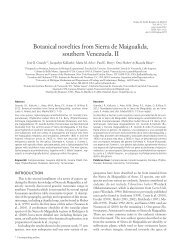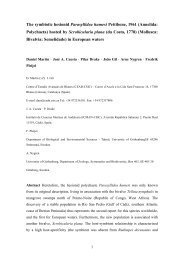Laser Synthesis and Luminescence Properties of SrAl2O4 ... - CSIC
Laser Synthesis and Luminescence Properties of SrAl2O4 ... - CSIC
Laser Synthesis and Luminescence Properties of SrAl2O4 ... - CSIC
Create successful ePaper yourself
Turn your PDF publications into a flip-book with our unique Google optimized e-Paper software.
greenish emission is attributed to Eu 2+ located inside the host lattice. The width <strong>of</strong> the<br />
b<strong>and</strong>s confirms this result as it is due to the splitting <strong>of</strong> the mixed 4f5d state by the<br />
crystal field <strong>of</strong> the host lattice. Furthermore, no emission peaks in the red region from<br />
the characteristic intraconfigurational transition 4f → 4f <strong>of</strong> Eu 3+ have been detected,<br />
indicating that the rare earth ions that have not diffused remain as divalent europium<br />
ions in the grain boundaries. Here, their concentration is so high in comparison to the<br />
reduced area <strong>of</strong> grain boundaries, that the emission from these Eu 2+ ions could be<br />
largely quenched, resulting in shorter lifetime values than those corresponding to Eu 2+<br />
ions located inside the grains. On the other h<strong>and</strong>, the wavelength <strong>of</strong> the emission b<strong>and</strong><br />
does not vary from <strong>SrAl2O4</strong>:Eu 2+ to <strong>SrAl2O4</strong>: Eu 2+ , Dy 3+ . The luminescent centers are<br />
Eu 2+ ions, <strong>and</strong> no additional emission b<strong>and</strong> assigned to Dy 3+ is found in <strong>SrAl2O4</strong>: Eu 2+ ,<br />
Dy 3+ . As expected, only the phosphors co-doped with Dy 3+ exhibit significant long-<br />
lasting afterglow properties. 2<br />
Decay curves <strong>of</strong> the afterglow <strong>of</strong> <strong>SrAl2O4</strong>:Eu 2+ <strong>and</strong> <strong>SrAl2O4</strong>: Eu 2+ , Dy 3+ samples<br />
at room temperature are depicted in Fig. 10. The luminescence decay process <strong>of</strong> the<br />
samples is nonexponential. Both decay processes <strong>of</strong> luminescence undergo an initial<br />
fast decay (not shown), followed by a slow decaying process which accounts for the<br />
observed long-lasting phosphorescence. The fast decay process corresponds to the<br />
intrinsic lifetime <strong>of</strong> Eu 2+ . The slower decay process, which is significant only in<br />
<strong>SrAl2O4</strong>: Eu 2+ , Dy 3+ samples, is attributed to the presence <strong>of</strong> Dy 3+ ions into the host<br />
lattice.<br />
The measured luminescent properties <strong>of</strong> the phosphors synthesized by this novel<br />
laser melting method can be explained in terms <strong>of</strong> the thermally-activated hole trapping<br />
<strong>and</strong> detrapping mechanism proposed by Matsuzawa et al. 2,31 Based on it, the Dy 3+ ions<br />
act as deep hole trapping centers. Upon UV-light exposure, Eu 2+ excitation occurs as a

















